C11 Systems Thinking: Fast Track Design Bid Build Project
VerifiedAdded on 2022/09/16
|13
|1847
|27
Project
AI Summary
This project delves into the analysis of a fast-track Design Bid Build construction project system, examining the relationships between key stakeholders: the client, consultants, and the main contractor. The analysis begins with an introduction to the construction industry's challenges, including fragmentation, low technology adoption, and economic pressures. The project then explores the system's environment, utilizing the Viable Systems Model to understand the organization's structure and operations. Hard system tools, such as flowcharts, swimlane process maps, and value stream maps, are applied to illustrate project workflows. Subsequently, the project employs Soft System Methodology (SSM) to address the "messy problem" of conflicting objectives and lack of trust among stakeholders. The project defines the root definition, CATWOE analysis, and conceptual model, culminating in recommendations derived from SSM to improve system behavior and performance. The project highlights the importance of collaboration, transparency, and mutual respect to enhance project outcomes within the competitive and time-sensitive construction environment.
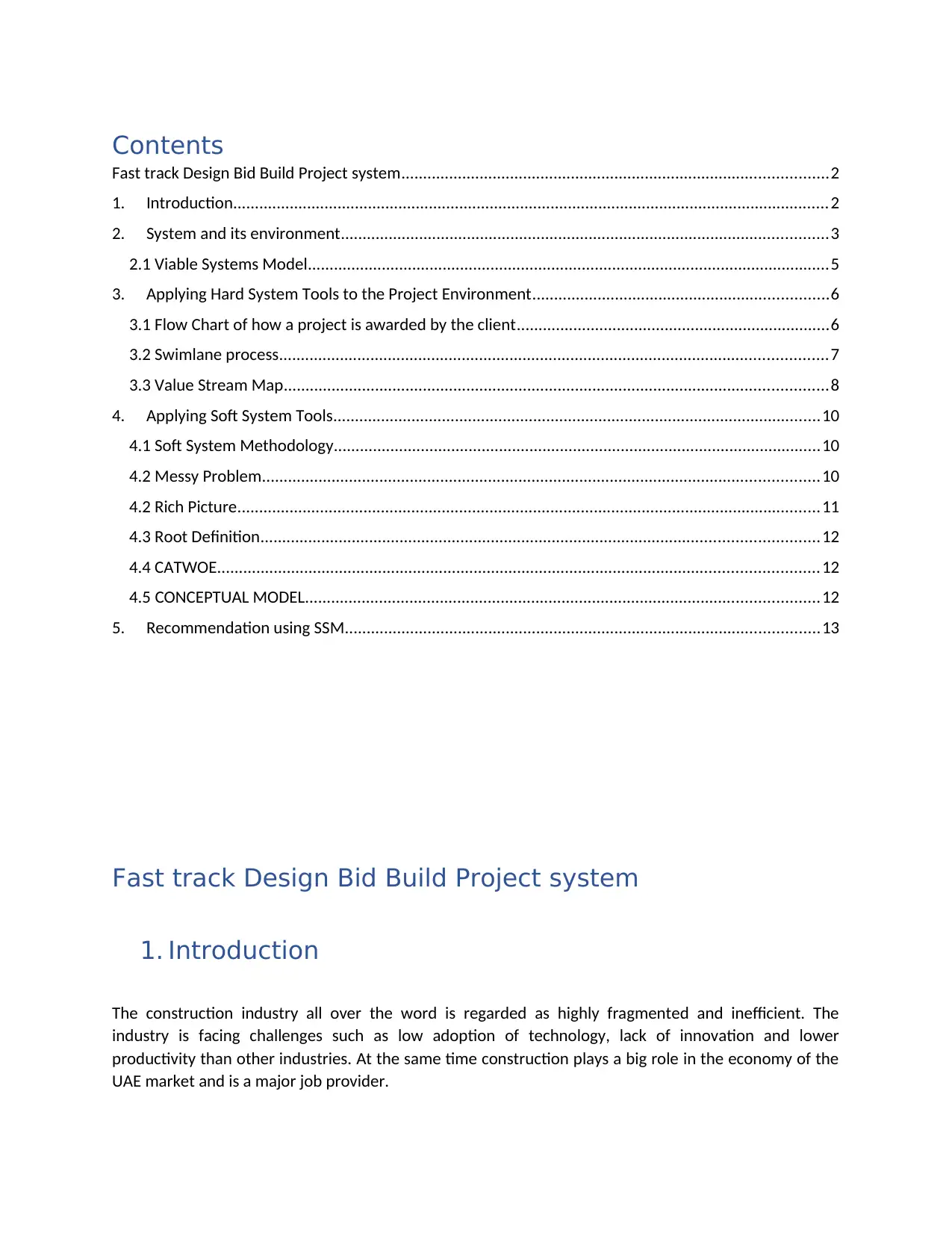
Contents
Fast track Design Bid Build Project system..................................................................................................2
1. Introduction.........................................................................................................................................2
2. System and its environment................................................................................................................3
2.1 Viable Systems Model........................................................................................................................5
3. Applying Hard System Tools to the Project Environment....................................................................6
3.1 Flow Chart of how a project is awarded by the client........................................................................6
3.2 Swimlane process..............................................................................................................................7
3.3 Value Stream Map.............................................................................................................................8
4. Applying Soft System Tools................................................................................................................10
4.1 Soft System Methodology................................................................................................................10
4.2 Messy Problem................................................................................................................................10
4.2 Rich Picture......................................................................................................................................11
4.3 Root Definition................................................................................................................................12
4.4 CATWOE..........................................................................................................................................12
4.5 CONCEPTUAL MODEL......................................................................................................................12
5. Recommendation using SSM.............................................................................................................13
Fast track Design Bid Build Project system
1. Introduction
The construction industry all over the word is regarded as highly fragmented and inefficient. The
industry is facing challenges such as low adoption of technology, lack of innovation and lower
productivity than other industries. At the same time construction plays a big role in the economy of the
UAE market and is a major job provider.
Fast track Design Bid Build Project system..................................................................................................2
1. Introduction.........................................................................................................................................2
2. System and its environment................................................................................................................3
2.1 Viable Systems Model........................................................................................................................5
3. Applying Hard System Tools to the Project Environment....................................................................6
3.1 Flow Chart of how a project is awarded by the client........................................................................6
3.2 Swimlane process..............................................................................................................................7
3.3 Value Stream Map.............................................................................................................................8
4. Applying Soft System Tools................................................................................................................10
4.1 Soft System Methodology................................................................................................................10
4.2 Messy Problem................................................................................................................................10
4.2 Rich Picture......................................................................................................................................11
4.3 Root Definition................................................................................................................................12
4.4 CATWOE..........................................................................................................................................12
4.5 CONCEPTUAL MODEL......................................................................................................................12
5. Recommendation using SSM.............................................................................................................13
Fast track Design Bid Build Project system
1. Introduction
The construction industry all over the word is regarded as highly fragmented and inefficient. The
industry is facing challenges such as low adoption of technology, lack of innovation and lower
productivity than other industries. At the same time construction plays a big role in the economy of the
UAE market and is a major job provider.
Paraphrase This Document
Need a fresh take? Get an instant paraphrase of this document with our AI Paraphraser
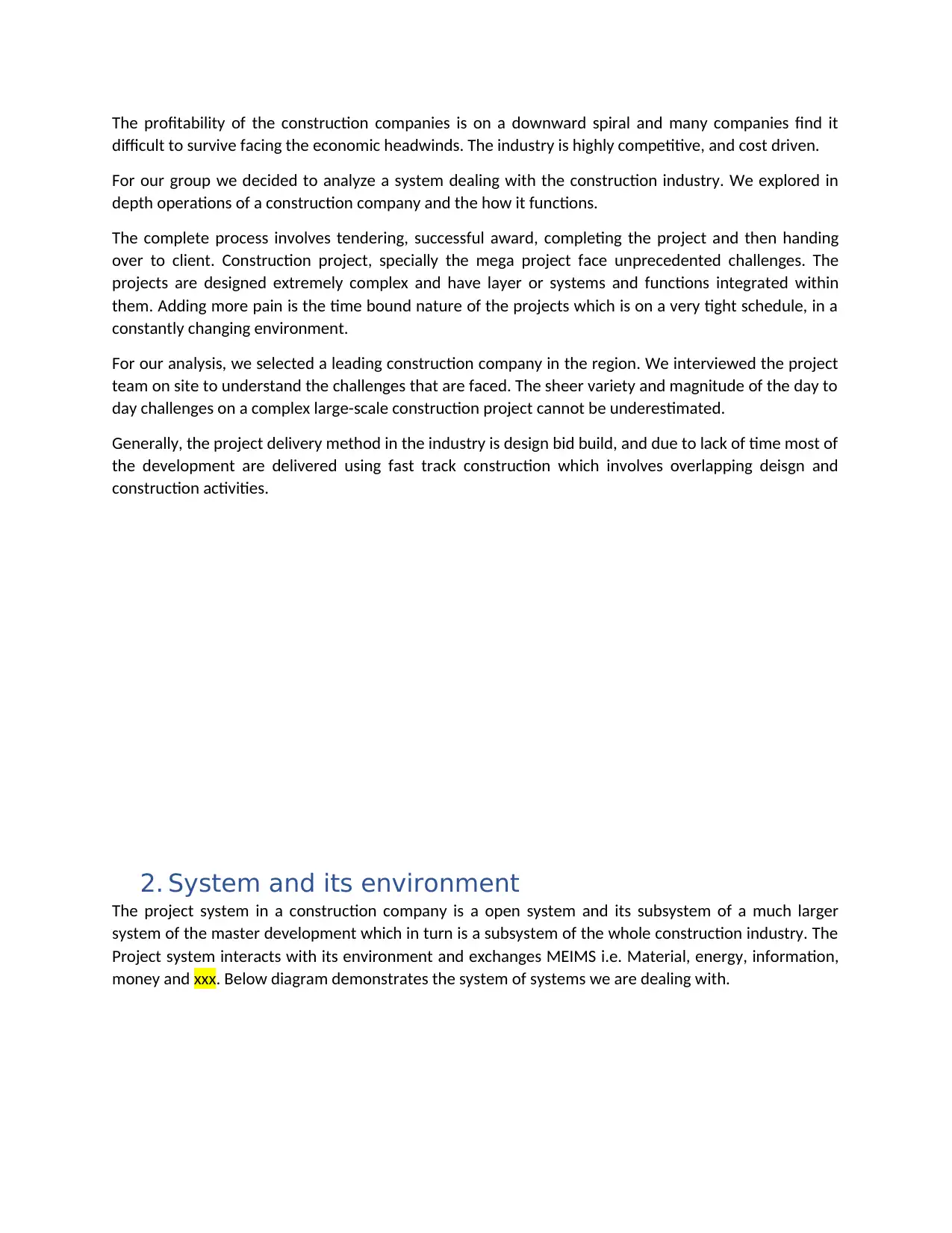
The profitability of the construction companies is on a downward spiral and many companies find it
difficult to survive facing the economic headwinds. The industry is highly competitive, and cost driven.
For our group we decided to analyze a system dealing with the construction industry. We explored in
depth operations of a construction company and the how it functions.
The complete process involves tendering, successful award, completing the project and then handing
over to client. Construction project, specially the mega project face unprecedented challenges. The
projects are designed extremely complex and have layer or systems and functions integrated within
them. Adding more pain is the time bound nature of the projects which is on a very tight schedule, in a
constantly changing environment.
For our analysis, we selected a leading construction company in the region. We interviewed the project
team on site to understand the challenges that are faced. The sheer variety and magnitude of the day to
day challenges on a complex large-scale construction project cannot be underestimated.
Generally, the project delivery method in the industry is design bid build, and due to lack of time most of
the development are delivered using fast track construction which involves overlapping deisgn and
construction activities.
2. System and its environment
The project system in a construction company is a open system and its subsystem of a much larger
system of the master development which in turn is a subsystem of the whole construction industry. The
Project system interacts with its environment and exchanges MEIMS i.e. Material, energy, information,
money and xxx. Below diagram demonstrates the system of systems we are dealing with.
difficult to survive facing the economic headwinds. The industry is highly competitive, and cost driven.
For our group we decided to analyze a system dealing with the construction industry. We explored in
depth operations of a construction company and the how it functions.
The complete process involves tendering, successful award, completing the project and then handing
over to client. Construction project, specially the mega project face unprecedented challenges. The
projects are designed extremely complex and have layer or systems and functions integrated within
them. Adding more pain is the time bound nature of the projects which is on a very tight schedule, in a
constantly changing environment.
For our analysis, we selected a leading construction company in the region. We interviewed the project
team on site to understand the challenges that are faced. The sheer variety and magnitude of the day to
day challenges on a complex large-scale construction project cannot be underestimated.
Generally, the project delivery method in the industry is design bid build, and due to lack of time most of
the development are delivered using fast track construction which involves overlapping deisgn and
construction activities.
2. System and its environment
The project system in a construction company is a open system and its subsystem of a much larger
system of the master development which in turn is a subsystem of the whole construction industry. The
Project system interacts with its environment and exchanges MEIMS i.e. Material, energy, information,
money and xxx. Below diagram demonstrates the system of systems we are dealing with.
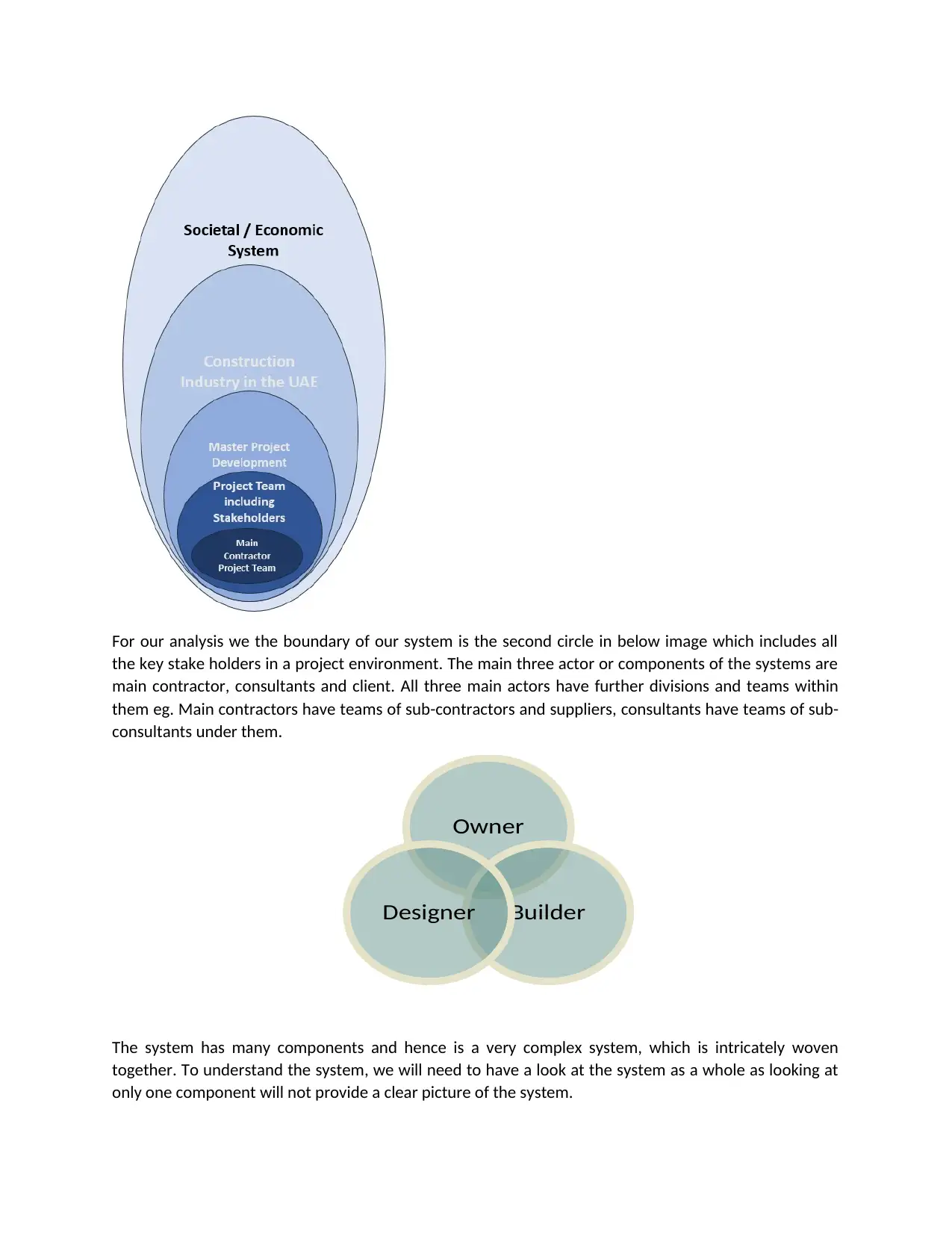
For our analysis we the boundary of our system is the second circle in below image which includes all
the key stake holders in a project environment. The main three actor or components of the systems are
main contractor, consultants and client. All three main actors have further divisions and teams within
them eg. Main contractors have teams of sub-contractors and suppliers, consultants have teams of sub-
consultants under them.
The system has many components and hence is a very complex system, which is intricately woven
together. To understand the system, we will need to have a look at the system as a whole as looking at
only one component will not provide a clear picture of the system.
Owner
BuilderDesigner
the key stake holders in a project environment. The main three actor or components of the systems are
main contractor, consultants and client. All three main actors have further divisions and teams within
them eg. Main contractors have teams of sub-contractors and suppliers, consultants have teams of sub-
consultants under them.
The system has many components and hence is a very complex system, which is intricately woven
together. To understand the system, we will need to have a look at the system as a whole as looking at
only one component will not provide a clear picture of the system.
Owner
BuilderDesigner
⊘ This is a preview!⊘
Do you want full access?
Subscribe today to unlock all pages.

Trusted by 1+ million students worldwide
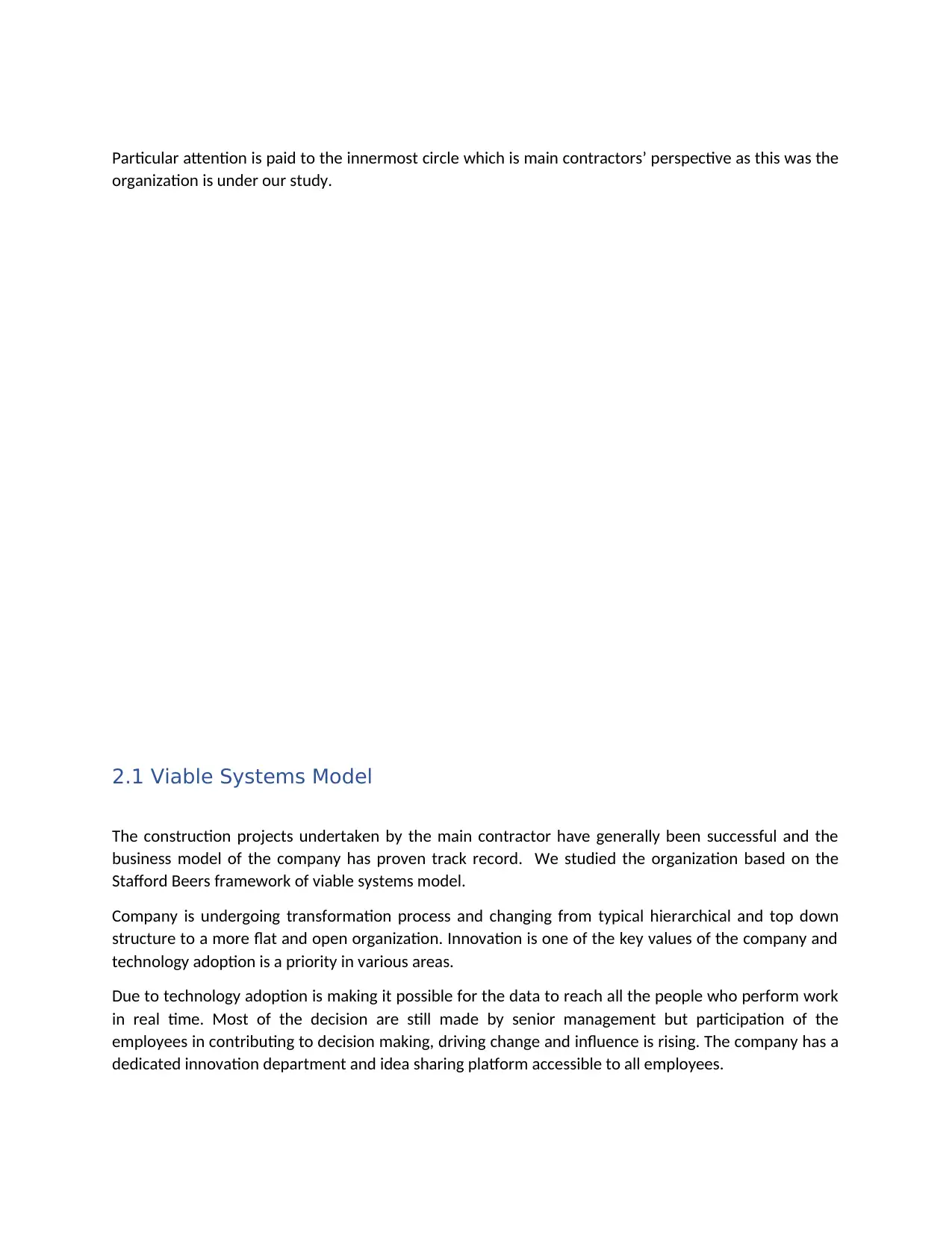
Particular attention is paid to the innermost circle which is main contractors’ perspective as this was the
organization is under our study.
2.1 Viable Systems Model
The construction projects undertaken by the main contractor have generally been successful and the
business model of the company has proven track record. We studied the organization based on the
Stafford Beers framework of viable systems model.
Company is undergoing transformation process and changing from typical hierarchical and top down
structure to a more flat and open organization. Innovation is one of the key values of the company and
technology adoption is a priority in various areas.
Due to technology adoption is making it possible for the data to reach all the people who perform work
in real time. Most of the decision are still made by senior management but participation of the
employees in contributing to decision making, driving change and influence is rising. The company has a
dedicated innovation department and idea sharing platform accessible to all employees.
organization is under our study.
2.1 Viable Systems Model
The construction projects undertaken by the main contractor have generally been successful and the
business model of the company has proven track record. We studied the organization based on the
Stafford Beers framework of viable systems model.
Company is undergoing transformation process and changing from typical hierarchical and top down
structure to a more flat and open organization. Innovation is one of the key values of the company and
technology adoption is a priority in various areas.
Due to technology adoption is making it possible for the data to reach all the people who perform work
in real time. Most of the decision are still made by senior management but participation of the
employees in contributing to decision making, driving change and influence is rising. The company has a
dedicated innovation department and idea sharing platform accessible to all employees.
Paraphrase This Document
Need a fresh take? Get an instant paraphrase of this document with our AI Paraphraser
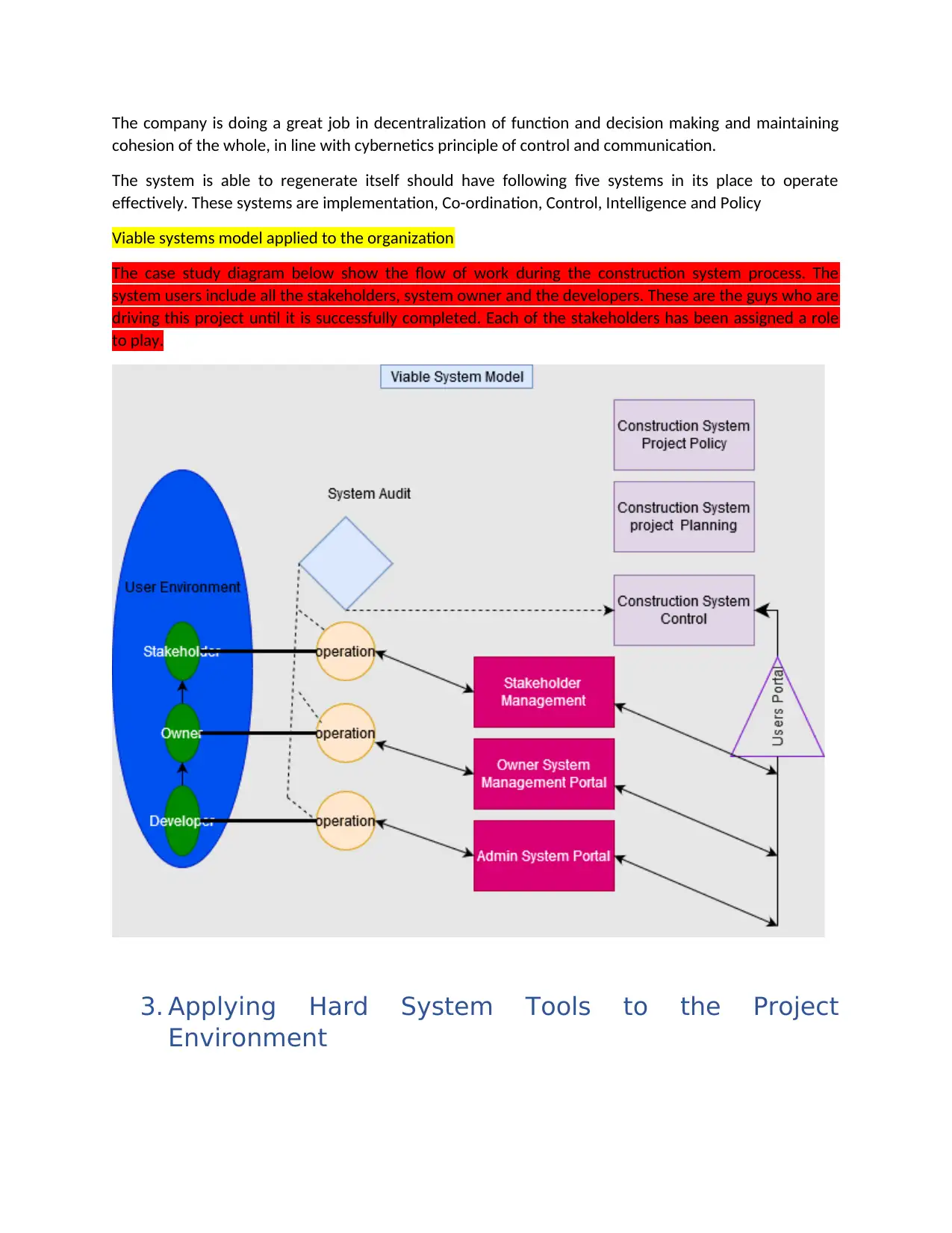
The company is doing a great job in decentralization of function and decision making and maintaining
cohesion of the whole, in line with cybernetics principle of control and communication.
The system is able to regenerate itself should have following five systems in its place to operate
effectively. These systems are implementation, Co-ordination, Control, Intelligence and Policy
Viable systems model applied to the organization
The case study diagram below show the flow of work during the construction system process. The
system users include all the stakeholders, system owner and the developers. These are the guys who are
driving this project until it is successfully completed. Each of the stakeholders has been assigned a role
to play.
3. Applying Hard System Tools to the Project
Environment
cohesion of the whole, in line with cybernetics principle of control and communication.
The system is able to regenerate itself should have following five systems in its place to operate
effectively. These systems are implementation, Co-ordination, Control, Intelligence and Policy
Viable systems model applied to the organization
The case study diagram below show the flow of work during the construction system process. The
system users include all the stakeholders, system owner and the developers. These are the guys who are
driving this project until it is successfully completed. Each of the stakeholders has been assigned a role
to play.
3. Applying Hard System Tools to the Project
Environment
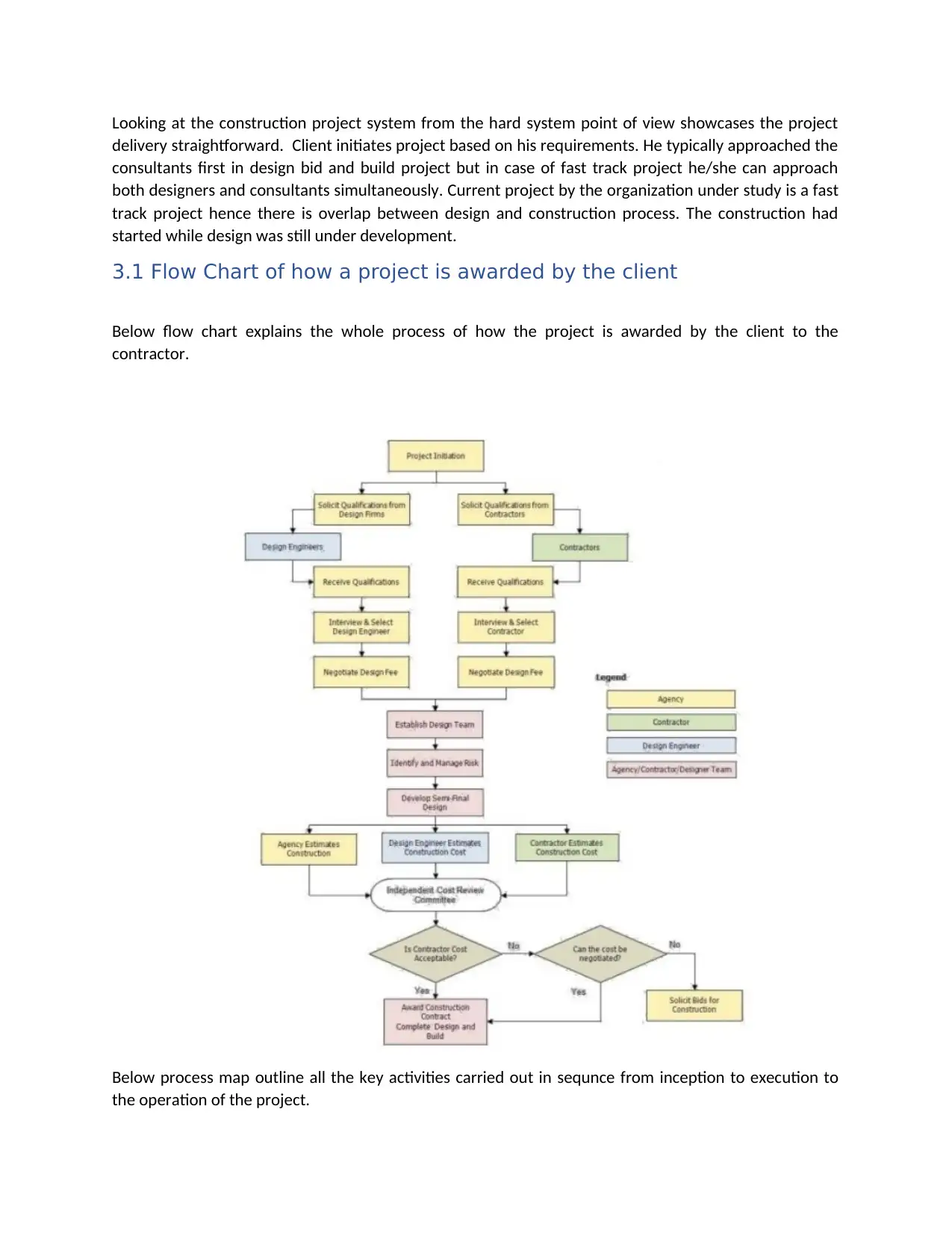
Looking at the construction project system from the hard system point of view showcases the project
delivery straightforward. Client initiates project based on his requirements. He typically approached the
consultants first in design bid and build project but in case of fast track project he/she can approach
both designers and consultants simultaneously. Current project by the organization under study is a fast
track project hence there is overlap between design and construction process. The construction had
started while design was still under development.
3.1 Flow Chart of how a project is awarded by the client
Below flow chart explains the whole process of how the project is awarded by the client to the
contractor.
Below process map outline all the key activities carried out in sequnce from inception to execution to
the operation of the project.
delivery straightforward. Client initiates project based on his requirements. He typically approached the
consultants first in design bid and build project but in case of fast track project he/she can approach
both designers and consultants simultaneously. Current project by the organization under study is a fast
track project hence there is overlap between design and construction process. The construction had
started while design was still under development.
3.1 Flow Chart of how a project is awarded by the client
Below flow chart explains the whole process of how the project is awarded by the client to the
contractor.
Below process map outline all the key activities carried out in sequnce from inception to execution to
the operation of the project.
⊘ This is a preview!⊘
Do you want full access?
Subscribe today to unlock all pages.

Trusted by 1+ million students worldwide
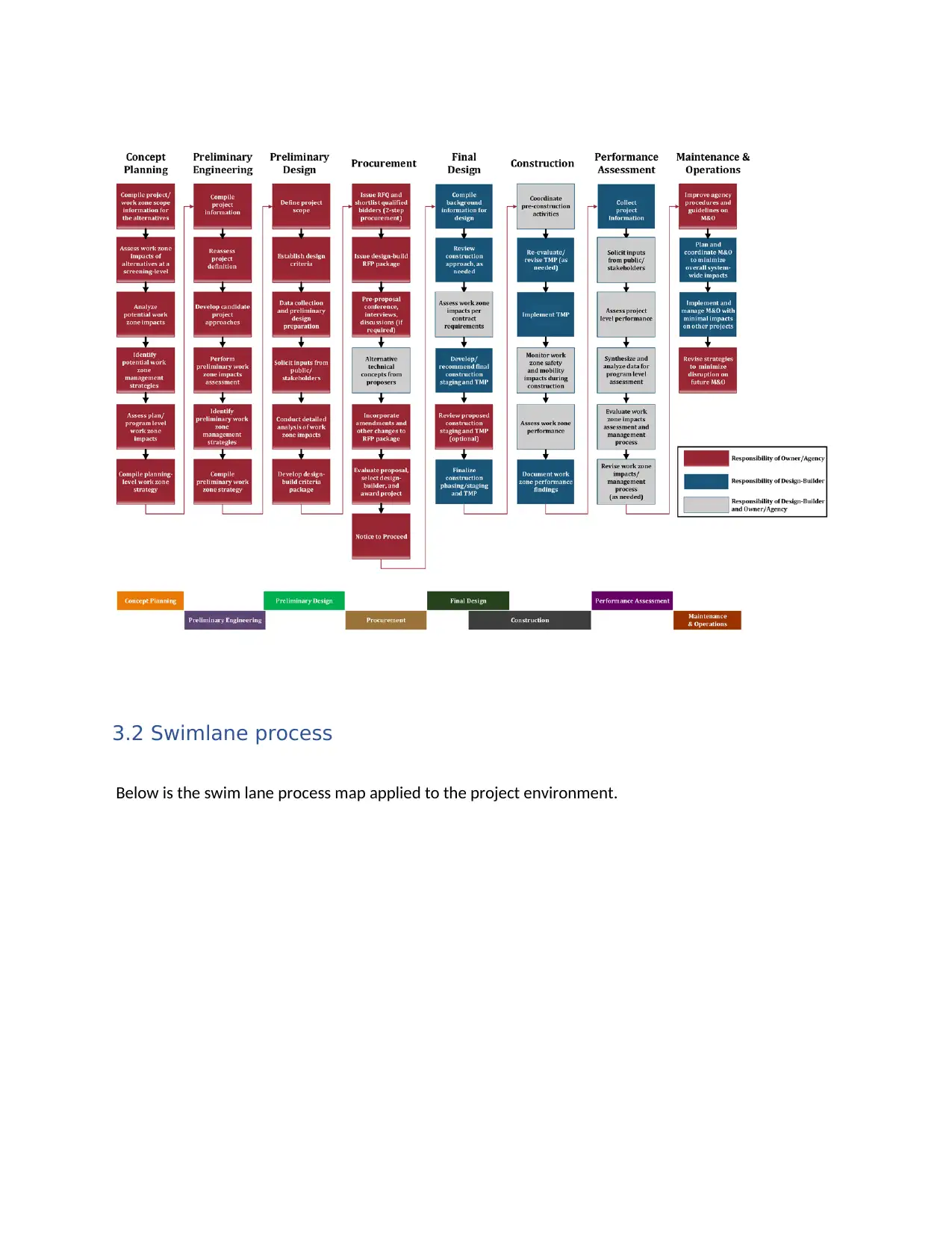
3.2 Swimlane process
Below is the swim lane process map applied to the project environment.
Below is the swim lane process map applied to the project environment.
Paraphrase This Document
Need a fresh take? Get an instant paraphrase of this document with our AI Paraphraser
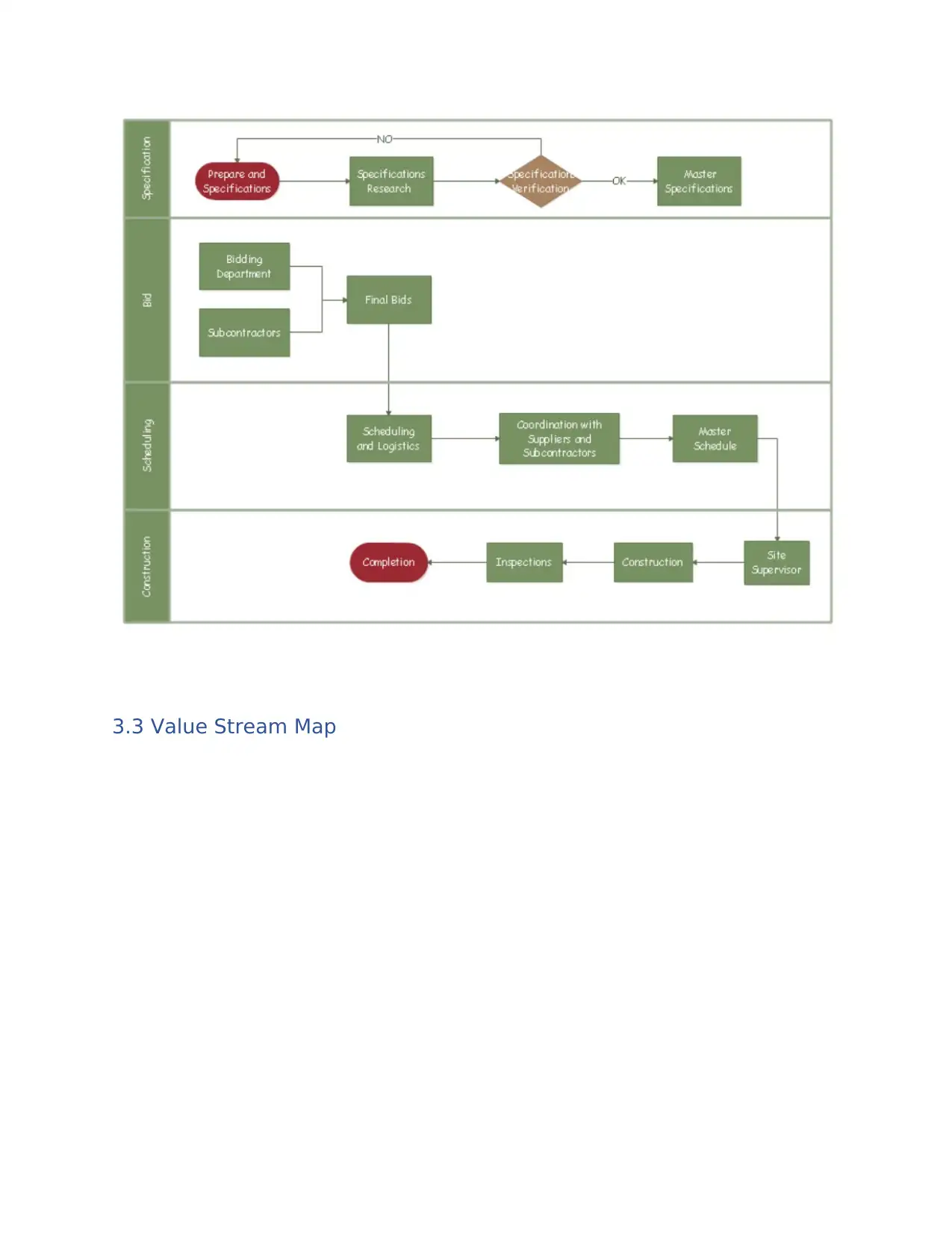
3.3 Value Stream Map

Value Stream Map applied to project of organization
This is the lean management plan from the period of production to the period that the product is being
delivered. The plan requires those who implement the project or those in production and the customer
who is supposed to order for the deliveries. A work schedule has to be designed to allow the
implementing the system model to meet the deadlines as scheduled.
This is the lean management plan from the period of production to the period that the product is being
delivered. The plan requires those who implement the project or those in production and the customer
who is supposed to order for the deliveries. A work schedule has to be designed to allow the
implementing the system model to meet the deadlines as scheduled.
⊘ This is a preview!⊘
Do you want full access?
Subscribe today to unlock all pages.

Trusted by 1+ million students worldwide

4. Applying Soft System Tools
4.1 Soft System Methodology
Different perceptions exist in the minds of different people or even in different organizations. Checkland
() has come up with a methodology to transform these perceptions or ideas into practical use, which
doesn’t try to reduce the complexity. The messy problematic situation is considered which will be
present as long as there is human activity involved. SSM can be effectively applied to complex problems
which itself cannot be defined or formulated due to complexity and human behaviors involved.
SSM forced us to investigate the culture of the company and study the people component of the
organization in detail. Learning the processes and interactions is the focus of SSM and it does not involve
looking at the root cause of the problem but rather accept the situation as it is.
Below digarm explains how seven steps of SSM is applied to the messy problematic situation.
4.1 Soft System Methodology
Different perceptions exist in the minds of different people or even in different organizations. Checkland
() has come up with a methodology to transform these perceptions or ideas into practical use, which
doesn’t try to reduce the complexity. The messy problematic situation is considered which will be
present as long as there is human activity involved. SSM can be effectively applied to complex problems
which itself cannot be defined or formulated due to complexity and human behaviors involved.
SSM forced us to investigate the culture of the company and study the people component of the
organization in detail. Learning the processes and interactions is the focus of SSM and it does not involve
looking at the root cause of the problem but rather accept the situation as it is.
Below digarm explains how seven steps of SSM is applied to the messy problematic situation.
Paraphrase This Document
Need a fresh take? Get an instant paraphrase of this document with our AI Paraphraser
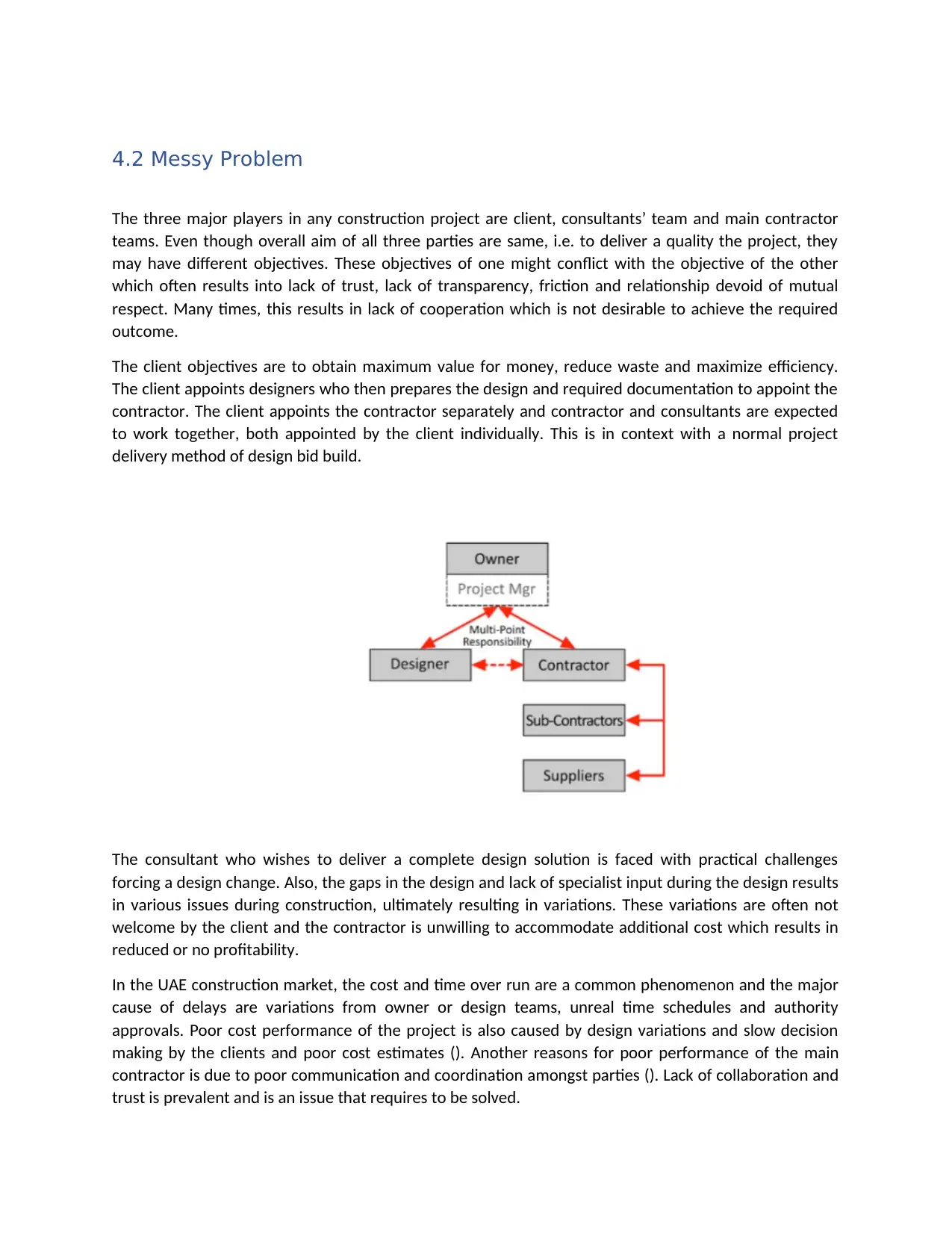
4.2 Messy Problem
The three major players in any construction project are client, consultants’ team and main contractor
teams. Even though overall aim of all three parties are same, i.e. to deliver a quality the project, they
may have different objectives. These objectives of one might conflict with the objective of the other
which often results into lack of trust, lack of transparency, friction and relationship devoid of mutual
respect. Many times, this results in lack of cooperation which is not desirable to achieve the required
outcome.
The client objectives are to obtain maximum value for money, reduce waste and maximize efficiency.
The client appoints designers who then prepares the design and required documentation to appoint the
contractor. The client appoints the contractor separately and contractor and consultants are expected
to work together, both appointed by the client individually. This is in context with a normal project
delivery method of design bid build.
The consultant who wishes to deliver a complete design solution is faced with practical challenges
forcing a design change. Also, the gaps in the design and lack of specialist input during the design results
in various issues during construction, ultimately resulting in variations. These variations are often not
welcome by the client and the contractor is unwilling to accommodate additional cost which results in
reduced or no profitability.
In the UAE construction market, the cost and time over run are a common phenomenon and the major
cause of delays are variations from owner or design teams, unreal time schedules and authority
approvals. Poor cost performance of the project is also caused by design variations and slow decision
making by the clients and poor cost estimates (). Another reasons for poor performance of the main
contractor is due to poor communication and coordination amongst parties (). Lack of collaboration and
trust is prevalent and is an issue that requires to be solved.
The three major players in any construction project are client, consultants’ team and main contractor
teams. Even though overall aim of all three parties are same, i.e. to deliver a quality the project, they
may have different objectives. These objectives of one might conflict with the objective of the other
which often results into lack of trust, lack of transparency, friction and relationship devoid of mutual
respect. Many times, this results in lack of cooperation which is not desirable to achieve the required
outcome.
The client objectives are to obtain maximum value for money, reduce waste and maximize efficiency.
The client appoints designers who then prepares the design and required documentation to appoint the
contractor. The client appoints the contractor separately and contractor and consultants are expected
to work together, both appointed by the client individually. This is in context with a normal project
delivery method of design bid build.
The consultant who wishes to deliver a complete design solution is faced with practical challenges
forcing a design change. Also, the gaps in the design and lack of specialist input during the design results
in various issues during construction, ultimately resulting in variations. These variations are often not
welcome by the client and the contractor is unwilling to accommodate additional cost which results in
reduced or no profitability.
In the UAE construction market, the cost and time over run are a common phenomenon and the major
cause of delays are variations from owner or design teams, unreal time schedules and authority
approvals. Poor cost performance of the project is also caused by design variations and slow decision
making by the clients and poor cost estimates (). Another reasons for poor performance of the main
contractor is due to poor communication and coordination amongst parties (). Lack of collaboration and
trust is prevalent and is an issue that requires to be solved.
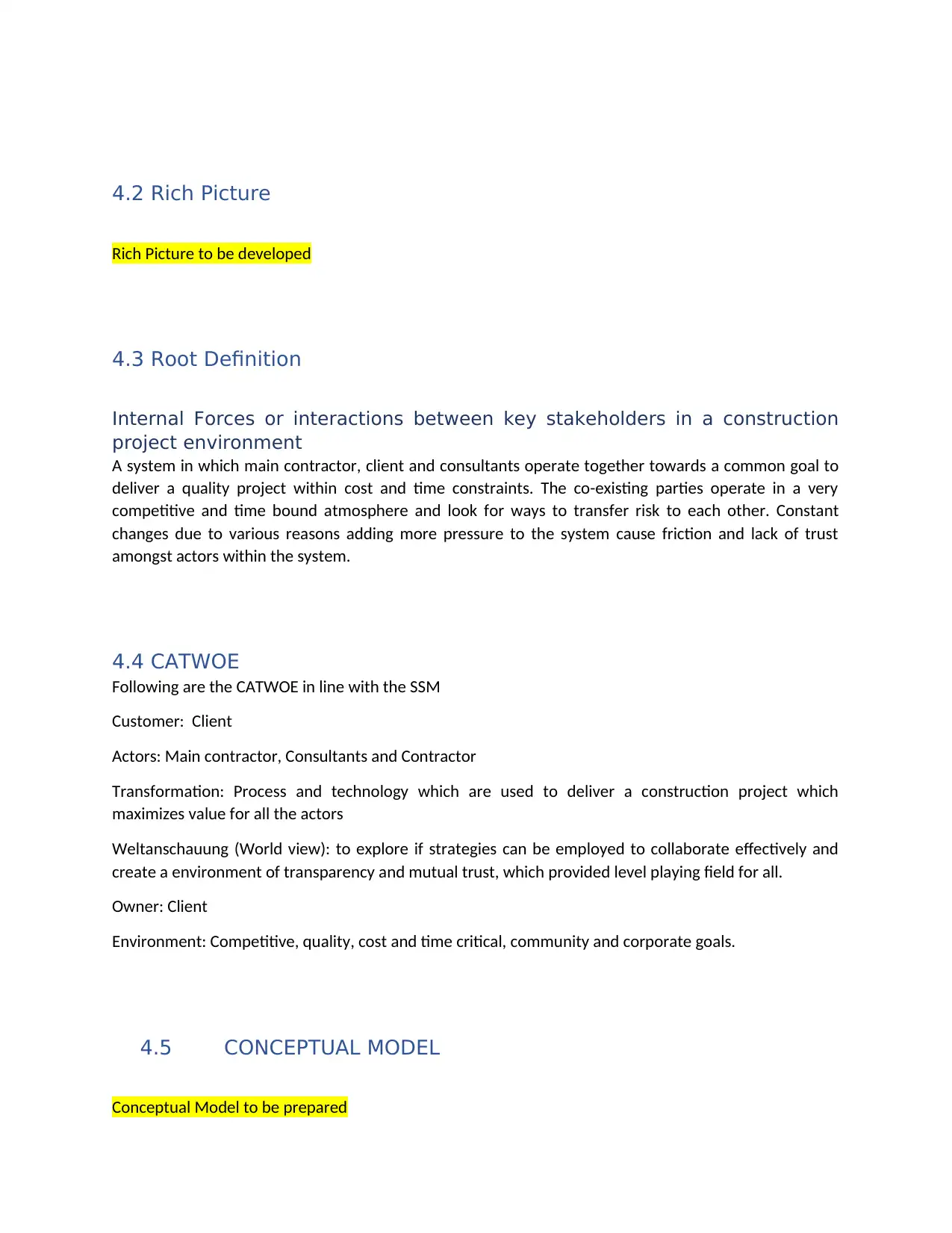
4.2 Rich Picture
Rich Picture to be developed
4.3 Root Definition
Internal Forces or interactions between key stakeholders in a construction
project environment
A system in which main contractor, client and consultants operate together towards a common goal to
deliver a quality project within cost and time constraints. The co-existing parties operate in a very
competitive and time bound atmosphere and look for ways to transfer risk to each other. Constant
changes due to various reasons adding more pressure to the system cause friction and lack of trust
amongst actors within the system.
4.4 CATWOE
Following are the CATWOE in line with the SSM
Customer: Client
Actors: Main contractor, Consultants and Contractor
Transformation: Process and technology which are used to deliver a construction project which
maximizes value for all the actors
Weltanschauung (World view): to explore if strategies can be employed to collaborate effectively and
create a environment of transparency and mutual trust, which provided level playing field for all.
Owner: Client
Environment: Competitive, quality, cost and time critical, community and corporate goals.
4.5 CONCEPTUAL MODEL
Conceptual Model to be prepared
Rich Picture to be developed
4.3 Root Definition
Internal Forces or interactions between key stakeholders in a construction
project environment
A system in which main contractor, client and consultants operate together towards a common goal to
deliver a quality project within cost and time constraints. The co-existing parties operate in a very
competitive and time bound atmosphere and look for ways to transfer risk to each other. Constant
changes due to various reasons adding more pressure to the system cause friction and lack of trust
amongst actors within the system.
4.4 CATWOE
Following are the CATWOE in line with the SSM
Customer: Client
Actors: Main contractor, Consultants and Contractor
Transformation: Process and technology which are used to deliver a construction project which
maximizes value for all the actors
Weltanschauung (World view): to explore if strategies can be employed to collaborate effectively and
create a environment of transparency and mutual trust, which provided level playing field for all.
Owner: Client
Environment: Competitive, quality, cost and time critical, community and corporate goals.
4.5 CONCEPTUAL MODEL
Conceptual Model to be prepared
⊘ This is a preview!⊘
Do you want full access?
Subscribe today to unlock all pages.

Trusted by 1+ million students worldwide
1 out of 13
Related Documents
Your All-in-One AI-Powered Toolkit for Academic Success.
+13062052269
info@desklib.com
Available 24*7 on WhatsApp / Email
![[object Object]](/_next/static/media/star-bottom.7253800d.svg)
Unlock your academic potential
Copyright © 2020–2025 A2Z Services. All Rights Reserved. Developed and managed by ZUCOL.




